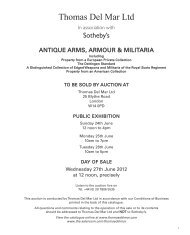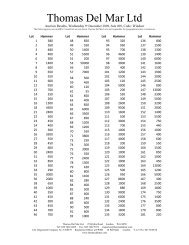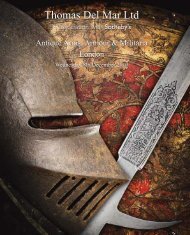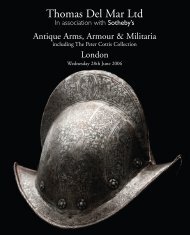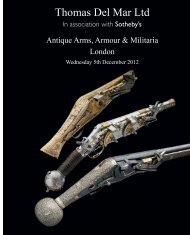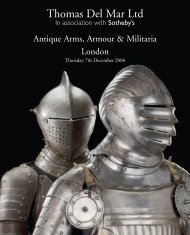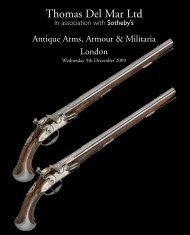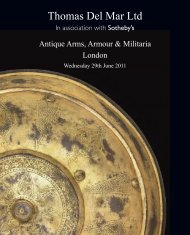You also want an ePaper? Increase the reach of your titles
YUMPU automatically turns print PDFs into web optimized ePapers that Google loves.
259<br />
A COMPOSITE EUROPEAN FIELD ARMOUR, 16TH<br />
CENTURY<br />
comprising close helmet formed of a one-piece skull rising<br />
to a high roped comb (crest damaged, the lower left corner<br />
of the face-opening patched) and fitted at the nape with a<br />
plume-holder, earlier visor and bevor attached by common<br />
pivots (replaced), the former of rounded ‘sparrow’s-beak’<br />
114<br />
259<br />
form having a stepped centrally-divided vision-slit and<br />
numerous small circular ventilation-holes at each side (the<br />
right edge patched, the beak pierced with two large rustholes),<br />
and two gorget-plates front and rear (the lower front<br />
one restored, the lower rear one patched at its left end),<br />
early 17th century collar formed of a single deep plate front<br />
and rear, breastplate of late ‘peascod’ form (patched at the<br />
left side and centre of waist) with moveable gussets at each<br />
arm-opening, fauld of three lames, the lowest cut with a<br />
shallow arch over the crotch and bearing a pair of<br />
detachable tassets each of nine lames, extending to just<br />
above the knees, one-piece backplate shaped to the<br />
shoulders and flanged outwards at its lower edge (patch at<br />
left of flange) to receive a culet of one lame (patched at<br />
either end), small symmetrical pauldrons each of six lames<br />
(the top three of the left and the top one of the right<br />
patched at their front ends) connected by turners to<br />
vambraces (not a pair) each formed of a tubular upper and<br />
lower cannon articulated to one another by a winged<br />
couter of three lames, the wing of the left one formed as a<br />
separate plate, mitten gauntlets (not an exact pair), each<br />
formed of a long pointed tubular cuff, five metacarpalplates,<br />
a knuckle-plate with boldly roped transverse rib, and<br />
four finger plates (thumb-defences lacking), and a pair of<br />
19th century greaves of tubular construction each<br />
articulated four times at the ankle, pierced with an aperture<br />
to accommodate a spur and fitted with an integral broadtoed<br />
sabaton of seven lames, the main edges of the armour<br />
turned inwards and decorated, except on the collar, with<br />
file-roping, the collar decorated with incised bands and<br />
borders enclosed by volutes, chevrons and punched beads,<br />
the breastplate, backplate, pauldrons and upper cannons of<br />
the vambraces etched in line with symmetrical sprays of<br />
stylised acanthus foliage issuing, in the case of the<br />
breastplate, from a grotesque mask at the centre of the<br />
neck-opening, the couters, upper cannons of the<br />
vambraces, gauntlets and tassets later etched on a<br />
blackened ground with quatrefoils framed in part by<br />
repeated lozenges and engrailed bands (showing significant<br />
pitting and wear with some cracking, bruising, perforation<br />
and disarticulation throughout), stand not included<br />
Inv. no. A086.<br />
The etched decoration of the breastplate, backplate,<br />
pauldrons and upper cannons of the vambraces identifies<br />
them as part of a series of armours made for the use of the<br />
Swiss Papal Guard. Other armours of the series can be<br />
recorded in the Museo Civico L. <strong>Mar</strong>zoli, Brescia, Inv. Nos<br />
860, 927-8, 941 & 947, see F. Rossi & N. di Carpegna 1969,<br />
Cat. Nos 22-5 & 44, pp. 22-3 & 30); the Fitzwilliam Museum,<br />
Cambridge, Acc. No. Hen. M.1.2A-c-1933, see I. Eaves<br />
2002, pp. 123-5, ill.; and the Art Institute, Chicago, see W.<br />
J.. Karcheski, Jr 1995, p. 68, ill.. The decoration, originally<br />
gilt on a blued ground, has in all cases been applied about<br />
1700 to elements of late 16th and early 17th century North<br />
Italian make.<br />
£18000-24000



